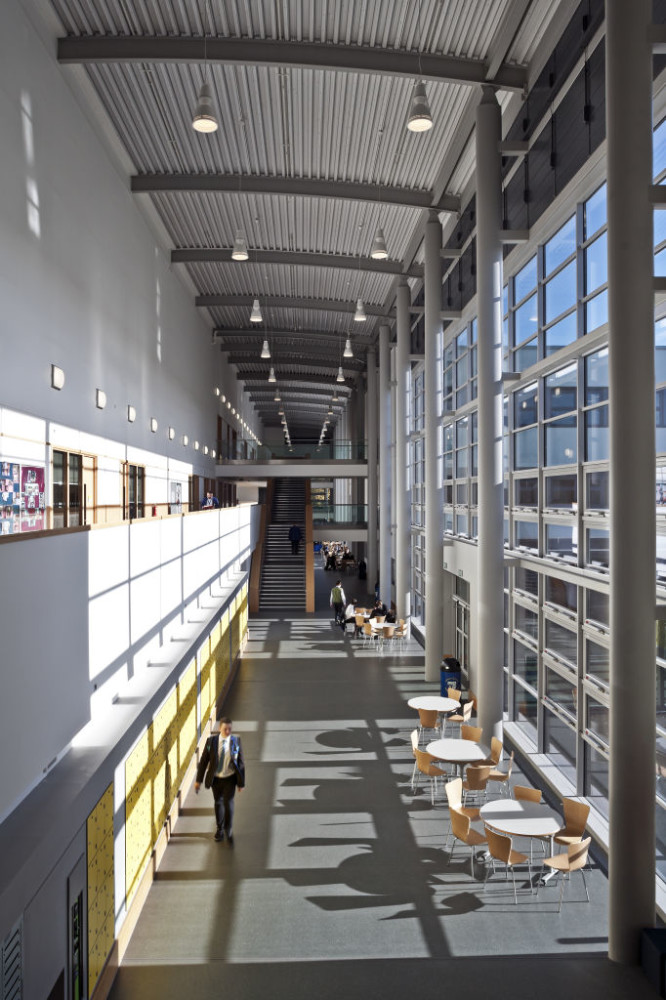
by Michael P. Toohey
Until now, design professionals have had to rely on adding off-the-shelf actuators to standard windows to provide automated natural ventilation in a building. With this as the only available solution, there have been several problems.
These standard products are often supplied by two different manufacturers, so integrating and getting them to work together properly can be challenging. Additionally, these components are generally not tested to work together as an assembly, so durability has been a concern.
This article discusses the history of ventilation, describes its principles, and compares it with mechanical ventilation. The issues examined consider when specifying a separate window and actuator compared to an integrated natural ventilation system; it also addresses the options available for natural ventilation.
History of ventilation
Ventilation—the process of supplying and removing air through an indoor space—can be accomplished either naturally or mechanically. While at home, the principles of natural ventilation are typically applied by simply opening the windows to let in fresh air and cool breezes. Mechanical ventilation is controlled by adjusting the thermostat to provide heat or air-conditioning to meet a required indoor temperature.
However, it is rare to find a commercial building with operable windows for natural ventilation,
so there is usually little control over the climate in work environments. Most workers will either adapt to the conditions or complain to someone who has control. Typically, the only course of action is to make a thermostat adjustment.
Igloos, teepees, Roman atria, and Persian wind-catchers are all past examples of how the natural flow of air was harnessed for indoor climate control or to simply exhaust smoke and fumes.
It is theorized the first example of mechanical ventilation was developed in the 1500s in the Middle East when air movement was accomplished by servants pulling ropes attached to ceiling-suspended canvas-covered frames. In the 1700s, John Theophilus Desaguliers invented a paddle fan that used centrifugal force to move stale air out of mines; later, the Industrial Revolution saw mechanical ventilation systems used in large buildings such as Great Britain’s Houses of Parliament. As mechanical systems progressed, New Orleans resident Schuyler Wheeler invented the first electric fan in 1882. This breakthrough in mechanical ventilation led to perhaps the most dramatic impact. In 1902, Willis Carrier developed the first air-conditioning system, changing indoor environments forever and lessening desire for natural ventilation in commercial buildings.
Today, natural ventilation is making a strong comeback in commercial buildings. Driven by factors such as high energy costs, unhealthy indoor environments, and the need to protect the ecosystem, natural ventilation is becoming an increasingly popular method to manage indoor environments.

How natural ventilation works
Buoyancy and air flow are the two principle drivers to naturally ventilate a building. Buoyancy refers to the principle that less-dense hot air will rise inside a building as cooler air is introduced. This relies on the temperature difference between indoor and outdoor air and employs stack ventilation, where rising warm air exits the structure to create a vacuum effect that pulls in cooler exterior air from below. As wind or breezes enter a natural ventilator, this air flow combined with the buoyancy effect, creates a circulation inside the building that leads to a cooler and more comfortable environment. Air flow can also create cross-ventilation—the process where exterior air is wind-driven into ventilators on one side of a building, forcing interior air out of the other side.
In both cross- and stack ventilation, there does not need to be a significant difference between indoor and outdoor temperatures. The simple movement of air alone will greatly increase occupant comfort through the principles of heat transfer and evaporative cooling.
Natural ventilation offers various benefits over a standalone mechanical ventilation system. From a cost standpoint, a climate control system using natural ventilation will require a smaller and less expensive mechanical system. Smaller mechanical systems also require less energy; this, combined with the minimal power consumption of automated natural ventilators, offers added savings. Additionally, building operational budgets can also be lowered as natural ventilators require little maintenance, especially when compared to larger mechanical systems.
The fact natural ventilation consumes less energy also provides inherent environmental benefits as reduced energy consumption lowers hydrocarbon emissions. Natural ventilators also have little or no impact on the localized environment. Unlike mechanical systems, they generate no heat and make little noise, so there is virtually no negative impact on indoor conditions.
In addition to reduced cost and lessened environmental impact, natural ventilation also addresses sick building syndrome (SBS). This unhealthy effect occurs when there is not enough fresh air circulating into a building to push out the air containing excessive carbon dioxide (CO2), mold, mildew, or other pollutants. Both the U.S. National Safety Council (NSC) and the Canadian Center for Occupational Health and Safety (CCOHS) have identified insufficient outdoor air intake as a common cause of indoor air quality (IAQ) problems. In the United Kingdom, the National Health Service (NHS) has stated “office workers in modern buildings without opening windows and with mechanical ventilation or air-conditioning are most at risk.”





Moving air around in a building is not ventilation. Ventilation is bringing in fresh air from the outside. I don’t believe most office buildings have any means of bringing in fresh air. Am I wrong? How can this be fixed if the windows don’t open?
A cirkulációval!Vákum,áramlás,stb.